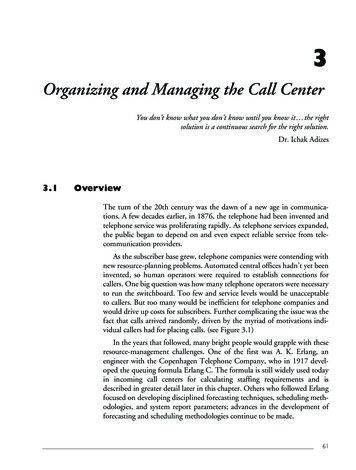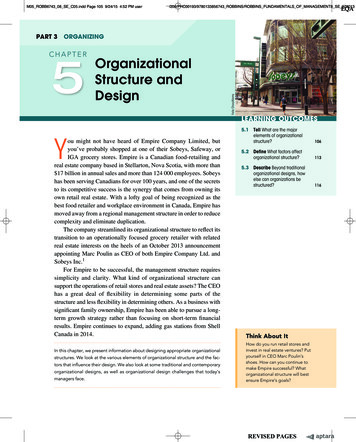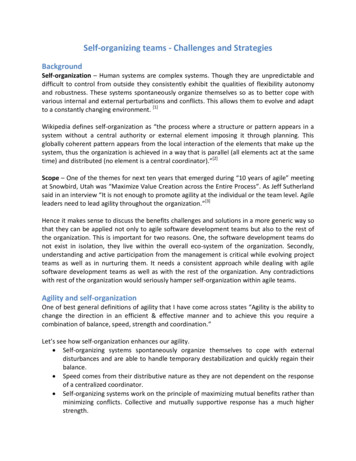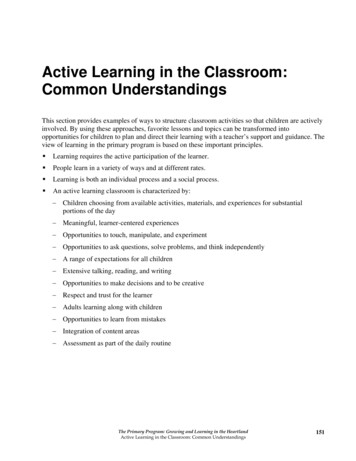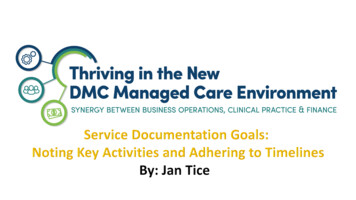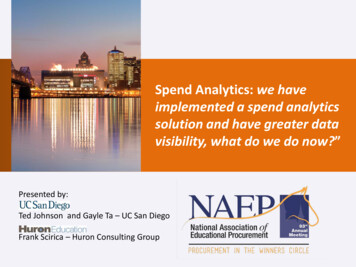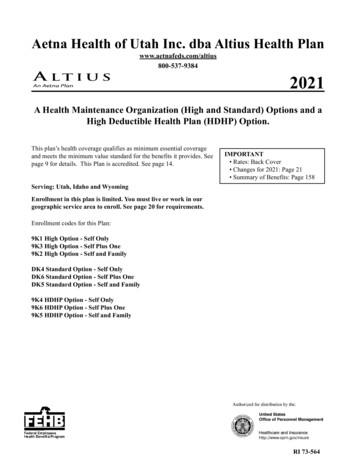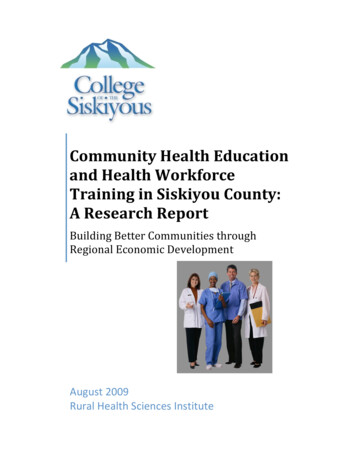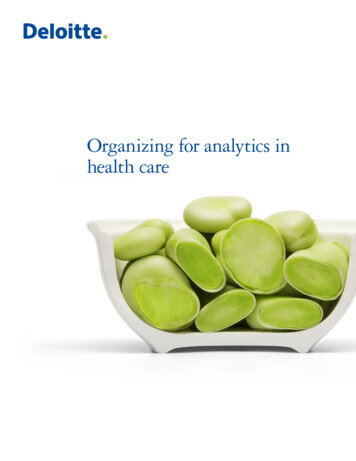
Transcription
Organizing for analytics inhealth care
ContentsIntroduction3What is analytics?4What are common pitfalls health care organizations face today?5What is the leading way to organize for analytics?6So where should you start?10What can be the benefits of getting it right?11Organizing for analytics in health care2
The growing thirst for information – reliably accurateinformation, is dramatically changing the health careindustry in many ways. Externally, the government,industry groups, payers, employers and patients aredemanding more insightful information, accountabilityand transparency. Internally, there is increasing demandfor clinicians and leaders to improve service quality, patientsatisfaction and clinical outcomes. At the same time,health care providers are being constantly challenged toprovide better results with fewer resources and at a lowercost. These external and internal forces can induce greaterperformance risk and are driving health care organizationsto develop a better understanding of their clinical andfinancial outcomes. The table stakes have changed in the“New Normal” - the ability to build enterprise informationmanagement and analytics capabilities that can providenew insights about patient populations that may beessential for organizations to thrive and ultimately, survive.A key to promoting sustainable enterprise excellence canlie in the organization’s ability to harness the potential ofclinical systems that can drive insights that enable informeddecision making. Organizations that have excelledat building information management and analyticalcapabilities (herein referred together as “Analytics”) haverealized tangible benefits such as: improving clinicaloutcomes, reducing insurance denials, reducing avoidablereadmissions, and increasing the use of resources to helpmeet the growing demand for patient services – just toname a few.Organizing for analytics in health care3
What is analytics?Business analytics typically focuses on areas such asfinancial performance, reimbursement, productivity andutilization. Clinical analytics focuses on areas that helpproviders deliver more effective and efficient clinical care(mortality and morbidity measures), increase patient safety(signal detection), and/or improve population care (publichealth programs, immunizations, market needs). Due tothe complexity of health care, it can be challenging to findthe desirable mix of business and clinical measures thatconvey a clear linkage between business or operationaldecisions and clinical outcomes. However with aneffective approach, an understanding of this linkage canoften yield powerful insights. As a result, the growingimportance of business and clinical analytics-driven processmeasures are becoming more prevalent as accountablecare, shifting reimbursement models, and service linestrategies may demand a holistic view that combinesclinical outcomes, financial and satisfaction measures.Regardless of the terminology used, the objective shouldbe to develop and implement a sustainable, adaptiveanalytics capability that handles the growing volume ofdata in a consistently reliable way and can yield insightsto improve both patient care and business performance.To help achieve this, it is important to first recognizethe potential barriers and roadblocks that cause manyprovider organizations to falter when tackling thecomplex opportunity that is analytics. Armed with thisunderstanding, the path to implementing an effectiveanalytics function can become clearer, more attainable,and a source of a new competitive advantage.4
What are common pitfalls healthcare organizations face today?Several challenges should be addressed in order toeffectively deploy and embed analytics in the organization’sculture, decision making processes, and operations.Aside from technical, data and skill considerations, thereare political, cultural and organizational pitfalls that canslow or stall the implementation of the program. Byanticipating and planning for these pitfalls, executivescan be better prepared to build support and maintainmomentum.Organizational barriersThere are several reasons why executives may struggle withthe question of where to place an analytics function in theorganization. First, the fact that the IT function often holdsresponsibility for the enterprise data warehouse (EDW) andreporting causes some organizations to view IT as a naturalowner of analytics. Second, in many organizations theFinance department has historically been one of the largestusers of analytics. Not only do they need information tosupport business decisions, they also can have a high needfor risk management and compliance data. Third, clinicalleadership requires clinical analytics insights and capabilitiesto compete in today’s market. Finally, the emergence ofgenomics and translational research are closely alignedwith care delivery and involve new complex data sets thathold the potential for clinical breakthroughs and newsources of revenue.Territorial disputes over dataMany executives have learned how to work aroundfragmented data and inefficient processes to get theinformation they need to be effective. As a result, controland ownership of data can often be a very personal andhighly political issue. Executives frequently make decisionswithin their own area of responsibility based on personalintuition and consensus, often because they lack access togood information or because it’s easier to rely on what hasworked in the past in other organizations. Overcoming thestatus quo to implement an enterprise analytics programshould require a combination of strong leadership and awillingness to drive behavioral change in the organization.Unclear roles and responsibilitiesAs organizations struggle with implementing an analyticsprogram, they realize priorities and roles should bedefined: what projects will be undertaken, how will projectrequests be prioritized, where will the skilled resourcescome from, what data is needed, how will that data bemaintained, and how will results be measured? Addressingsuch questions frequently involves several departments,data sources, staff, and conflicting priorities (e.g., whenanalytics are wanted fast, high quality, and at a low costby multiple departments at the same time). In the absenceof formal decision making protocols, such situationscan often lead to stalled projects, substandard results,and unsatisfied analytics customers. In other situations,departments who are frustrated with the inability to getthings done at the enterprise level, launch their ownindependent analytics efforts.Competition for resourcesIt is rare to find a health care organization that hassufficient staffing and skills to pursue all the analyticsopportunities. Many providers are struggling to recruit andretain experienced managers and analysts who possessthe combination of health care domain specialization, datamining knowledge, and experience with the vast array ofanalytics tools and methodologies. This resource constraintcan apply to business and clinical departments as well asthe IT organization where it is important to have accessto the data architects, programmers, and analysts whocan work effectively with end users. Conversely, functionaldepartments face similar challenges in that the individualswho possess the specific skills and domain knowledge areoften busy with their existing responsibilities.Organizing for analytics in health care5
What is the leading way toorganize for analytics?Transforming an organization to embrace an analyticsculture can take a significant commitment on the part ofexecutives, management and other stakeholders. Theability to implement an effective analytics program shouldbe more a function of leadership, structure, decision rights,and behavior change than a function of the size andcomplexity of the infrastructure or the technical platformsinvolved.Getting leadership to champion the analyticsprogramThe model analytics strategy should begin with strongexecutive leadership capable of bringing together talentedpeople with deep experience in applying analyticalmethods to clinical and business issues. These leadersshould take ownership of the deployment of theiranalyst talent to the best and highest use that supportsorganization’s mission and strategy. This means thatjockeying for resources for pet projects, building “shadow”analytics groups, or hiding strong analysts within a specificfunction should be discouraged. Instead, the team workstogether to identify and prioritize what particular analyticalissues the organization benefits most from addressing.With the desired executive alignment, the analyticsfunction can serve as the intersection of a company’sbusiness strategy, the data behind it, and the technologythat delivers it - which in concert helps improve anorganization’s performance. Once leadership has reachedagreement on which areas are of highest priority to theenterprise, they should then engage their staff to becomeanalytics champions and participants. These championsshould include management, clinicians, researchers,analysts, technologists, and others. Building support foranalytics needs leaders to work across silos to collaboratewith each other.6Aligning analytics resources with enterpriseprioritiesIt is important to establish an effective structure to helppromote collaborative behaviors. However, this cantypically prove challenging as organizations often houseanalysts within the functions they serve, creating silos thatwork against the enterprise analytics strategy. For example,financial analysts work on financial concerns while clinicalanalysts focus on patient care issues. An organizationshould answer “What is the leading way to align peopleso they are positioned to support the immediate andlong-term needs of the enterprise?” And alignmentdoesn’t mean just putting everyone in the same group as acentralized function, as discussed below.Structuring analytics in silos can limit analysts’ abilities tocollaborate on broad, strategic initiatives or complex issuesinvolving multiple areas of the business. By organizingresources so they can work across traditional boundariesnew insights can be obtained at the enterprise level thatcannot be developed in isolation. The biggest challengeis in balancing the need to keep them working “closeto the business” while enabling them to work “closelywith each other across the business”. By achieving thisbalance, organizations can realize the synergy of leveragingits combined knowledge, skills, tools and informationresources. Figure 1 illustrates three general approaches tostructuring an analytics function.
Figure 1 – Analytics delivery modelsCentralizedEnterpriseEnterpriseAnalytics GroupClinicalFinanceFunctionally StrengthsWeaknessesAll analyst groups report to onefunction at the enterprise level,even if they are assigned to servedifferent departments or functionsbased on strategic priorities set atthe corporate level. Resources mayalso be “engaged” by operatingunits for specific analytics projectsThis model enables an enterprisewide view of what is going on. Thismakes it easier to deploy analystson strategic projects, reducesconfusion, or limits competition forresources on functional initiativesReduced responsiveness todepartmental needs. Potential tocreate distance between analystsand business users, especially ifanalysts are located in a centrallocation. Risk of “shadow” analyticsgroups arising to address uniquebusiness requirements. Model mayfalter without strong enterprisefocus or leadershipIndividual analyst groups residesin departments that are strongconsumers of analytics. Whilegroups may provide limitedreporting to other departments,their primary focus is on the needsof their individual business unitsEasier to deploy resources toperform analytics within thedepartment. Highly responsive toindividual department needsDifficult to set enterprise priorities,limited incentive to share bestpractices or resources, conflictingdata. Often results in independentanalyst groups , resulting in lack ofcommunication, confusion, dataintegrity issues, duplication ofeffort, and unnecessary costsAnalysts groups exist at the healthsystem or enterprise level as wellas in departments or business unitsthat utilize analytics capabilities fortheir specific needs. Some commongovernance and standards topromote collaboration andknowledge-sharing among thecommunity.Promotes collaboration,knowledge-sharing while retainingdepartmental flexibility. Increasedcommunication facilitates anenterprise view of project prioritiesand status while reducing risk ofredundant projects and resources.Best model for bringing domainexperts together to enterprise orcomplex analytics issues.Requires a strong governancemodel in order to be effective.May take longer to fully implement.Conflicting priorities and resourceissues may arise due to theinformal nature or secondaryreporting line relationship.Analytics GroupCommunityEnterpriseEnterpriseAnalytics GroupClinicalFinanceAnalytics GroupAnalytics GroupNote: Whichever model is chosen, the IT function should be the recognized trustee of the organization’senterprise data resources and be responsible for overall data governance, infrastructure and standards.Analytics GroupClinicalFinanceAnalytics Projects*Adapted from “Analytics at Work”, Davenport and Harris, 2010Achieving this balance in a complex organization withinterrelated functions such as care delivery, research, andcommunity services involves recognizing that the needsvary greatly in different parts of the organization. Someanalytics applications function better in a centralizedenvironment to serve specialized needs (e.g., research,data management) or infrequent analytics users, whileother areas may likely benefit from a more distributedapproach that brings together the leading talent andresources from across the organization to achieve astrategic priority (e.g. promoting ser
the combination of health care domain specialization, data mining knowledge, and experience with the vast array of analytics tools and methodologies. This resource constraint can apply to business and clinical departments as well as the IT organization where it is important to have access to the data architects, programmers, and analysts who can work effectively with end users. Conversely .
